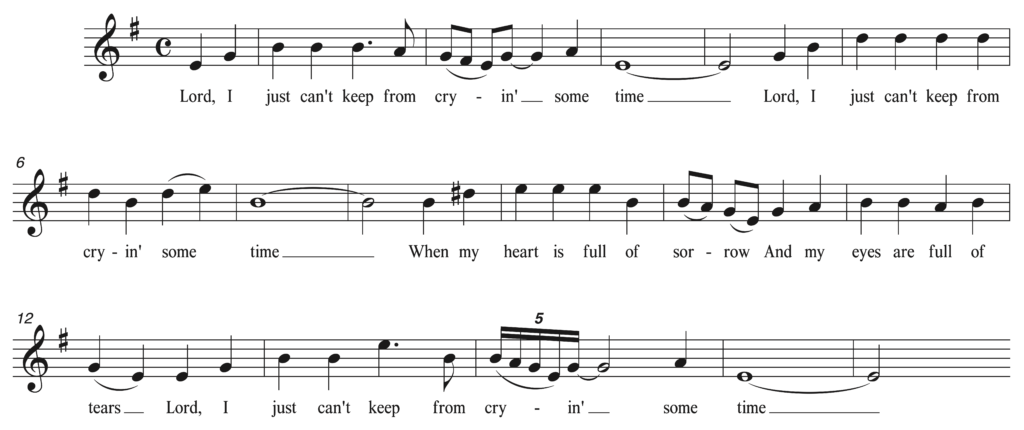Main Body
23 Text setting
Learning goals for Chapter 23
In this chapter, we will learn:
- Basic considerations for how to set English text for voice
- How to identify best practices for text setting in tonal music
Text setting
When we speak in English, some syllables receive emphasis and others do not. We can call syllables that receive emphasis “strong” or “accented” and those that don’t “weak” or “unaccented.” Take, for example, the adage “The early bird gets the worm.” When we speak this sentence aloud, the strong syllables are the first syllable of “early,” “bird,” “gets,” and “worm,” while the unaccented syllables are “the,” the second syllable of “early,” and “the.” It is relatively easy to analyze any phrase or sentence for strong and weak syllables by reading it aloud and noticing where you place greater emphasis. When we apply this procedure to poetry, we call it scansion.
We are exploring this topic for two reasons. First, we can gain a better appreciation of how composers and songwriters set texts by attending to how the musical settings interact with the syllabic emphasis of the text. Second, if you are interested in writing vocal music in any style, knowing these principles can make all the difference in making your music easier and more enjoyable to sing. To this end, we can identify two primary ways composers and songwriters set syllables that are emphasized in normal speech: (1) through placing emphasized syllables on downbeats and other metrically strong places, and (2) through using longer durations on emphasized syllables.
EXERCISE 23-1 Crash course in text setting
Study the text below and mark the syllables you would emphasize in normal speech.
Lord, I just can’t keep from cry-in’ some time
When my heart is full of sor-row
And my eyes are full of tears
Lord, I just can’t keep from cry-in’ some time.
Compare your analysis of important, emphasized syllables with how the text is set in the lead sheet for the spiritual “Lord, I Just Can’t Keep from Cryin’,” which appears in Worksheet example 23‑1. After listening to the recording of this song performed by Angela Brown, consider the following questions: In the musical setting of the text, which syllables are emphasized, and what are the ways in which emphasis is created musically?
Worksheet example 23‑1. Trad., “Lord, I Just Can’t Keep From Cryin’,” first verse
Video: T47 Primer to Text Setting (5:54)
This interactive video presents the primary ways musicians place logical emphasis on important syllables when setting text: (1) placing emphasized syllables on downbeats and other strong beats, and (2) giving these syllables longer durations. We explore the text of the first verse of the American spiritual, “Lord, I Just Can’t Keep from Cryin'” and how it is set in a compelling performance by singer Angela Brown (Worksheet example 23-1).
EXERCISE 23-2 Analysis of text setting and texture in Adolphus Hailstork’s Done Made My Vow
In 1985, American composer Adolphus Hailstork wrote a massive oratorio called Done Made My Vow. On a 1999 performance of the piece, critic Stephen Wigler writes:
[It] is scored for speaker, soprano, tenor and boy soprano soloists, large mixed chorus and orchestra. “Masterpiece” may not be too strong a word for it.
[ . . . ]
It is constructed along the lines of a church service and features a text by the composer that includes passages from the Bible and the speeches of Martin Luther King Jr. While Hailstork’s music draws upon both the sacred and secular traditions of African-American music, its formal features–such as the intricate interweaving of contrapuntal lines–testify to the composer’s mastery of the traditions of Western art music.[1]
In the section starting at m. 96, Hailstork sets the following text:
Done made my vow to the Lord, and I nev-er will turn back.
I will go. I shall go to see what the end will be.
Listen to the excerpt of this section and study the first few bars of the bass’s melody, shown in Worksheet example 23‑2. Underline the syllables above that are emphasized in his setting. Then write a sentence or two summarizing the ways in which the composer emphasizes the syllables musically. To back up your observations, provide specific examples from Worksheet example 23‑2. Finally, identify the best term to describe the texture of this passage based on your aural interpretation.
Worksheet example 23‑2. Adolphus Hailstork, Done Made My Vow, mm. 98–102, bass part
Listen to the full work, performed by the Baltimore Symphony Orchestra and Morgan State University Choir, conducted by Danial Hege and Nathan Carter, on YouTube.
Learn about American composer Adolphus Hailstork (b. 1941) by reading this Oxford Music Online article, written by Doris Evans McGinty.
For further reading
BaileyShea, Matthew. 2022. Lines and Lyrics: An Introduction to Poetry and Song. New Haven, CT: Yale University Press.
- Stephen Wigler, “Hailstork Work Intricate, Stirring,” Baltimore Sun, July 6, 1999, https://www.baltimoresun.com/news/bs-xpm-1999-07-06-9907060213-story.html. ↵


